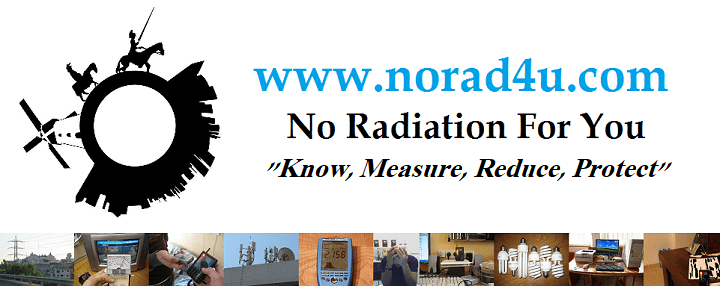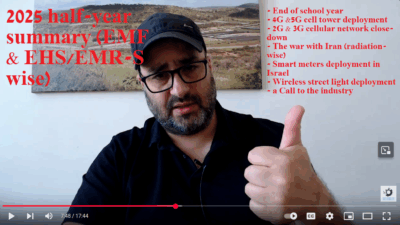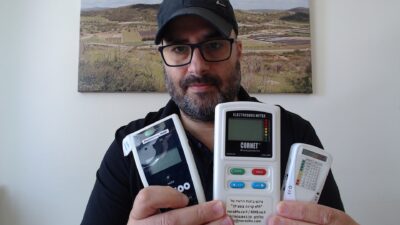The Ministry of Communications(IMC) in Israel, announces that by the end of the year (2025), It will shut down the 2G network (I think closing 2G is very good, as this network causes mobile phones to transmit at very high power), and the 3G network (which requires fewer antennas than 4G/5G, and provides adequate service, and in which cellur phones emit the lowest levels according to my testing in the last few years). Instead, they will expand the 4G and 5G networks, which require many more antennas (the vision of the IMC is a cellular antenna every 50 meters, in front of every home) and provide unnecessary premium services — all at the cost of increasing environmental and personal exposure for residents.
Ministry of Communications’ Facebook post – https://www.facebook.com/share/p/16p3B9W7cX/
The Ministry’s PR campaign reached all major news outlets:
https://www.maariv.co.il/economy/tech/article-1210922
https://www.news1.co.il/Archive/001-D-504498-00.html
https://www.israelhayom.co.il/…/tech-news/article/18324892
https://www.ice.co.il/media/news/article/1072555
Technical reason for the change
The technical reason for this change is to reuse the 700-900MHZ band, now being used by 3G &2G networks, by the new 4G and 5G networks. This will allow 4G and 5G signals to better penetrate buildings and houses. I think that in-house use of mobile phones is an abuse, as mobile phones are meant to be used outside the house, but most people are already addicted to it and use smartphones as their main or only communication device, in or outside the home.
More reasons and incentives (pay again + surveillance)
In my opinion, the transition is being made for several reasons (that are less known to the public):
- To force the public to switch to newer cell phones that support the newer 4G and 5G networks. Even those who are still satisfied using 2G or 3G devices will be forced to buy a new phone and move to 4G (paying again for something they already have).
- To create an artificial demand for the 4G network, thereby justifying the need to increase the number of antennas for 4G and 5G. This increases demand for the newer networks, allowing the authorities to justify the additional installation of new cellular antennas.
It should be noted that 3G networks require fewer antennas to provide wide coverage compared to 4G, and even more so compared to 5G. Currently, when there’s no 4G reception, phones switch to 3G. But once the 3G network is shut down (if that indeed happens), there will be reception problems in many parts of the country, and the proposed solution to that will be the installation of thousands of new antennas, eventually reaching a point where there’s an antenna every 50 meters, right across from people’s homes.
These antennas are also needed for autonomous driving and for more precise and dense user tracking. - Increased tracking capabilities on basic cellphone users – Every mobile phone allows the authorities to track its user. For example, even simple keypad phones allow to determine from which antenna the user is receiving service, and therefore estimate their location within the antenna’s coverage area.
Since 4G requires more antennas, each covering a smaller area, the precision of this basic location tracking increases compared to old 3G and 2G networks, where the cells are usually bigger. - Increased tracking capabilities on users with older smartphones – When it comes to smartphones, it’s possible to extract much more information from the device and perform far more precise tracking, using the phones’ GPS data, scans of nearby Bluetooth and Wi-Fi networks, and more. This allows, for example, identifying who you’ve been near throughout the day during a pandemic.
Since 2024, scanning of Bluetooth and Wi-Fi networks has been built into the operating routine of newer smartphones and enables tighter surveillance (these scans occur every time the screen is turned on). Now, with the shutdown of 3G networks, tens of thousands of users who were still using older smartphones—which don’t perform these scans—will be forced to upgrade to newer phones that do include this constant scanning. - The 4G and 5G communication protocols create a tighter link between the phone and the network compared to previous generations. As a result, the time between each transmittion becomes shorter, and the amount of data that can be extracted from the device increases, along with the potential for surveillance and control over the device.
Why is there a need to upgrade networks?
A. To keep up with advancing technology.
B. To transmit more data in less time – doesn’t always work, depends on signal strength.
C. To enable closer tracking/surveillance of users and increased data extraction/mining.
D. To push more data-hungry apps and services onto users.
E. To charge customers again for essentially the same service.
What are the differences between the generations?
1G (First Generation) – Analog and early digital, allowed voice calls only – no longer in use.
2G (Second Generation) – Digital, allows voice calls, SMS, and very limited internet. Requires fewer antennas. The phone transmits only during calls or when sending/receiving SMS, but when it does, the transmission power is relatively high compared to 3G.
3G (Third Generation) – Digital, allows calls, SMS, extensive internet use, video calls, music streaming, video watching, apps, and more. With smartphones, the phone transmits based on data usage, not just during calls or SMS. However, the transmission power is generally the lowest among all generations. Requires more antennas than 2G but fewer than 4G.
4G (Fourth Generation) – Digital, offers everything 3G does, but faster and with much more data. All communication is based on data, even voice calls are transmitted as data streams. Requires a stronger signal and many more antennas (than 3G). Enables premium services (e.g., 4K video streaming on mobile).
5G (Fifth Generation) – Digital, allows everything 4G offers, but even faster and with more data. In theory, enables ultra-fast, high-volume data transfer. Requires significantly more antennas than previous generations.
What determines how many antennas are needed?
- The generation of the network – The more “advanced” the generation, the more antennas are needed to provide basic coverage.
- Number of subscribers and users per cell – The more users in a given cell, the sooner the antenna serving that area reaches its full capacity, requiring the installation of an additional antenna and the splitting of the cell into two smaller ones.
This includes not only mobile phone users but also cars with cellular modems, IoT (Internet of Things) devices based on cellular modems, smart electricity meters that communicate via cellular modems, traffic light and control systems, police and security cameras, public information displays, industrial controllers, and other endpoints using cellular modems. - Traffic load in each cell – The greater the number of people or devices transferring large volumes of data over the cellular network, the more likely it is that the cell will need additional antennas to manage the load or to split the cell.
- Use in areas with weak or no reception – Using a phone in places like underground shelters, basements, or internal rooms, increases the transmission power of both the phone and the antenna.
- Thousands of uses in a specific area increase the likelihood that new antennas will be installed in front of homes or inside buildings.
How will the deployment of more and more cellular antennas be promoted?
The deployment of more cellular antennas will take place in several ways:
- New 4G and 5G antennas have been, and will continue to be, installed on existing towers. Antennas from 2G and 3G networks may be dismantled (possibly).
- Densifying the deployment of antennas on towers along roads, railways, and existing infrastructure near industrial buildings or agricultural areas, as was common in the past.
- Continued rollout of 5G antennas, especially in city centers and alongside major transportation routes.
- Accelerated deployment of physically smaller antennas (but not necessarily lower in radiation) in front of residential homes, on less conspicuous poles, sometimes integrated with lighting or other infrastructure.
- Accelerated deployment on power company infrastructure, such as substations, high-voltage towers (and even medium- and low-voltage poles).
- Accelerated deployment of cellular antennas on public buildings, including municipal and government facilities.
What I believe should have been done:
A. First and foremost, acknowledge the harm caused by radiation and recognize those affected. Radiation exposure limits should be set to levels up to 100,000 times lower than current standards.
B. Shut down 2G networks.
C. Keep and improve 3G networks to allow for basic mobile phone use outside the home.
D. 4G and 5G networks are entirely unnecessary. They should be shut down and their antennas dismantled.
E. Launch a public awareness campaign emphasizing that mobile phones are meant for short or emergency use outside the home , not for use in shelters, reinforced rooms, or interior spaces. Promote reasonable and moderate mobile use and discourage misuse (misuse = watching movies or series, downloading large files, etc.). Encourage the use of wired, landline-based home communication.
F. Begin developing a new generation of mobile technology with the primary requirement being minimal radiation, both from antennas and from the mobile devices themselves. The results should be tested using fast-response radiation meters that don’t average readings but instead measure peak radiation every half-second from hundreds of thousands of samples. These results should be compared to biological and health-based standards such as the BioInitiative 2012 recommendation (0.003 μW/cm²) or the guidelines of German Building Biologists.
What is blocking progress?
The problem is that the public wants to watch series and movies on their mobile phones, even in interior rooms at home, and many people have shifted to using mobile phones as their primary—or even sole—device. On the other hand, tech companies want to sell users new devices and premium 4G and 5G service packages.
Another issue is that if my recommendations were adopted, fewer devices and services would be sold, and the government would earn less from mobile customers and telecom companies. Therefore, the chances of change happening—before almost every family knows someone harmed by mobile radiation—are very, very, very slim.
An additional problem is that the industry currently controls the standards, and industry-funded bodies set those standards. This leads to scientific and regulatory fraud, where a false impression is created that current exposure levels meet protective standards (which protect industry more than the public) and that radiation, and using radiation emitting devices, poses no risk.
Industry-funded and industry-influenced scientific bodies in Israel and worldwide promote the belief that radiation is harmless, and those who are addicted but not yet harmed are happy to embrace that belief
The Vision of the Ministry of Communications
The vision of the Ministry of Communications stands in direct contrast to what I believe should be done. The ministry has set a goal to install cellular antennas on every street corner and in front of every home in the country, in order to achieve full coverage of 4G and 5G networks.
This deployment is being carried out under the cover of compliance with the high, non-protective radiation exposure limits of the Ministry of Environmental Protection—standards which were set by an industry-funded body (ICNIRP) that does not recognize the health risks of non-ionizing radiation.
Fulfilling this vision would allow mobile addicts to use their phones anywhere and as their primary or sole device. It would deepen the integration of cellular technology in personal, commercial, industrial, transportation, and infrastructure applications. It will enable telecom companies to extract more profits from increased network use and premium services, all at the expense of more and more RF radiation exposure from cellular antennas and devices, cripling public health, and deeply hurting of those already harmed or who may be harmed by radiation.
This vision is being promoted by the Ministry of Communications and the Ministry of Environmental Protection, under the promise of lowering radiation from mobile phones (which is far from guaranteed), while ignoring the expected rise in environmental radiation from the antennas, or dismising it as “SAFE” (expecting 5uW/cm2). The slogan used is “more antennas, less radiation,”, while a more accurate one would be:
“More antennas = sometimes less radiation from the phone, and always more environmental radiation.”

What you can do right now
- If you have a phone that supports 4G, for now, continue using 3G (while monitoring radiation levels with your fast RF radiation meter).
- If you don’t have a 4G phone, you can currently buy a simple 4G-compatible device (for just a few hundred shekels) or wait until things become clearer.
- Anyone who wants a smartphone will have no choice but to use 4G. Keep in mind that radiation from 4G phones is generally higher in most cases than radiation from a 3G phone. So if symptoms worsen or appear after shutting down the 3G network, consider that this might be the cause.
- Reduce exposure from your cell phone by keeping it away from your body whenever possible, even during calls and browsing.
- Reduce exposure by turning off transmissions you don’t need, such as Wi-Fi, Bluetooth, data communication, etc.
- Reduce dependence on your phone by returning to wired communication methods, such as a wired computer network at home and office, wired telephony, etc.
See guide – https://www.norad4u.com/guides/go-wired-guide/ - Be aware of the trend to install more and more cellular antennas near your home.
Check local antenna maps to see where the antennas are at, and where new antennas are going to be installed – https://www.norad4u.co.il/knowledge-h/cellphone-antennas/cellphone-antenna-maps/ - Buy a radiation meter and learn to use it. The meter will help you monitor your radiation exposure, reduce it, and better understand the issue. So when the transition happens and the 2G and 3G networks are shut down, and more antennas are installed around your home, you’ll be able to measure the change in environmental radiation in your home and area.
- Recommended radiation meter – https://www.norad4u.com/measure/home-use-emf-emr-elf-rf-meters-and-detectors/env-rd-100-emf-meter/
- Learn and get familiar with radiofrequency radiation shielding options in case you decide to protect your home.
- Radiation shielding – https://www.norad4u.com/emf-protection/rf-protection/
- Radiation shielding guide – https://www.norad4u.com/guides/no-rads-step-by-step-guide-for-rf-home-protection/
- Raise awareness among everyone willing to listen, especially those already affected.
- Explain especially the issue of more antennas = more environmental radiation, which is relatively easy to understand and concerns everyone.
- Especially for those sensitive to radiation, all the above points also apply to you. Additionally, focus on the following:
- Complete the process of learning, measuring, reducing exposure, switching to wired communication, and even shielding so that you are ready for the transition.
https://www.norad4u.com/guides/no-rads-4-steps-program/ - Start learning about shielding and try simple protection methods like using MYLAR.
- Be open to the idea of moving to communities with fewer people and fewer cellular antennas.
- Complete the process of learning, measuring, reducing exposure, switching to wired communication, and even shielding so that you are ready for the transition.



